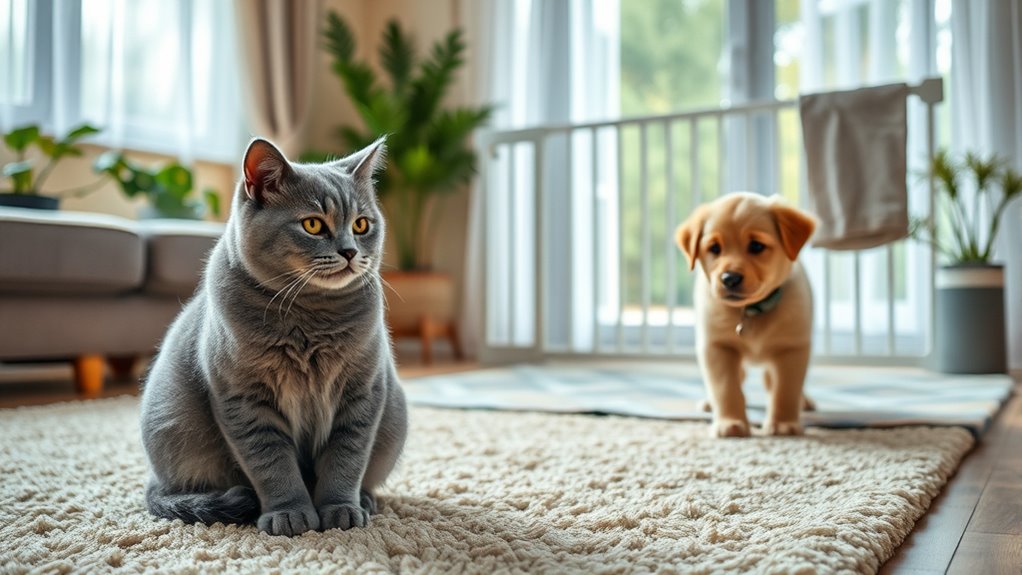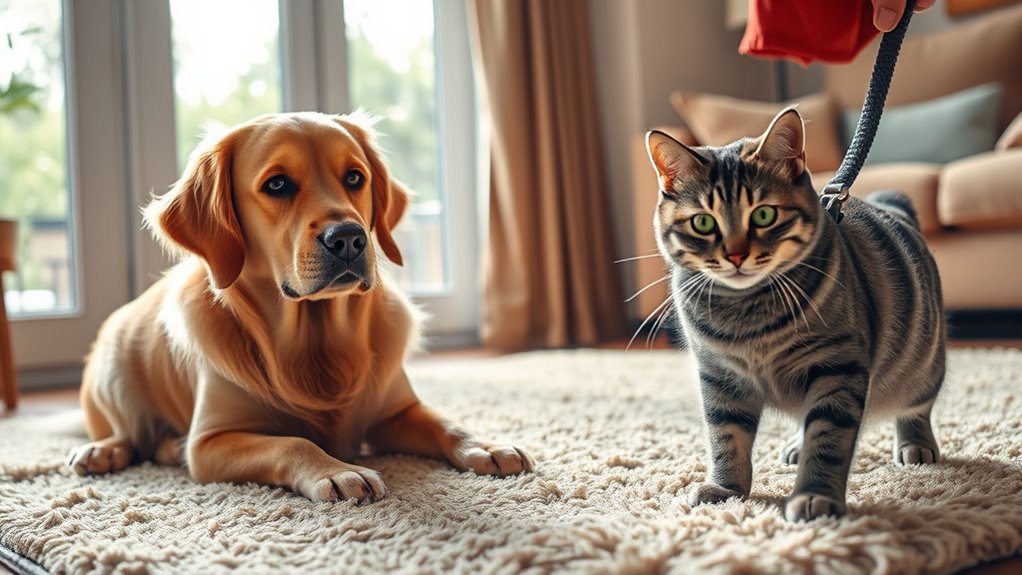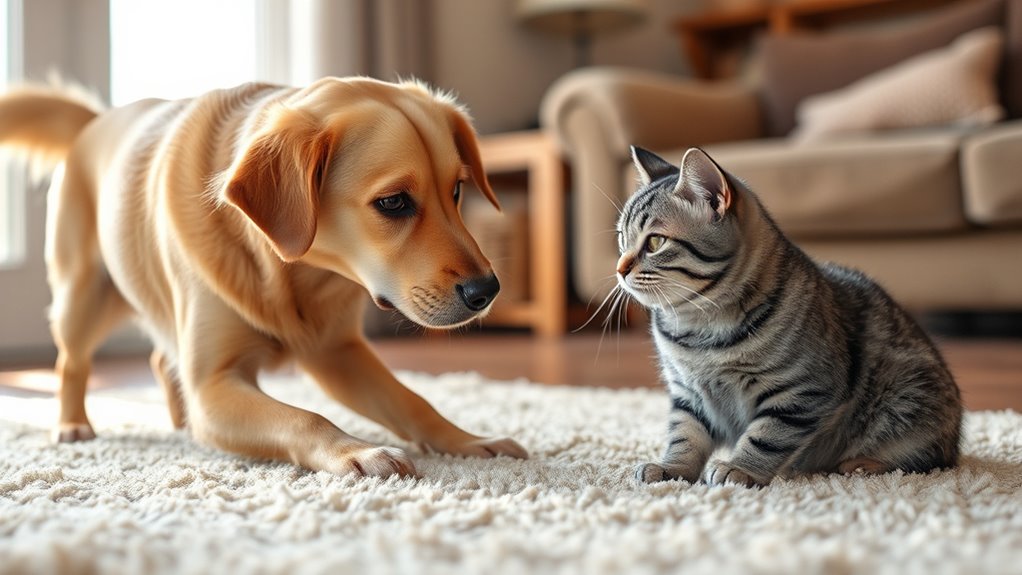When introducing your dog to your cat safely, start by swapping their scents with bedding or toys to reduce anxiety. Use barriers like baby gates for visual contact, and keep initial sessions brief and supervised, with your dog on a leash. Watch their body language for signs of comfort or stress, and reward calm behavior with treats and praise. Gradually increase the interaction time, and if you want to learn more about easing this process, keep exploring these helpful tips.
Key Takeaways
- Begin with scent swapping, allowing pets to familiarize themselves with each other’s smell before face-to-face meetings.
- Use visual barriers like baby gates to enable safe visual exposure without physical contact.
- Keep initial supervised interactions brief, on a leash, and in a controlled environment to monitor body language and prevent aggression.
- Reinforce calm behavior with treats and praise, and watch for signs of stress or tension to prevent escalation.
- Gradually increase interaction time as both pets show comfort and positive signals, ensuring a safe and stress-free introduction.
Preparing Your Pets and Environment

Before introducing your dog to your cat, it’s essential to prepare both your pets and their environment. Start with pet scent swapping by exchanging bedding or toys between them. This helps each animal become familiar with the other’s scent, reducing anxiety. Create a safe space for your cat, such as a separate room with essentials like food, water, and a litter box. This space allows your cat to retreat if needed and provides a calm environment to adjust. Keep your dog on a leash during initial interactions and supervise closely. Avoid forcing any contact; instead, let your pets explore their new environment at their own pace. Proper preparation helps ease stress and sets the foundation for a smoother, safer introduction. Proper environment setup can also influence the environment’s setup by ensuring safe, stable placement of pet furniture and accessories. Additionally, understanding animal behavior can help you interpret your pets’ reactions and respond appropriately during the introduction process. Recognizing body language cues is vital for early detection of stress or aggression, allowing for timely intervention. Incorporating positive reinforcement can encourage calm behavior and build positive associations between your pets.
Initial Meetings and Supervised Encounters

When introducing your dog to your cat for the first time, keep the initial encounter brief and controlled. This helps both pets feel safe and prevents overwhelming reactions. During the meeting, observe their body language cues closely—look for relaxed tails, calm postures, or ears forward, which indicate curiosity rather than aggression. To facilitate a smooth scent introduction, let your pets sniff each other’s belongings first, like blankets or toys, before the face-to-face meeting. A higher contrast ratio can also improve the clarity of visual cues during interactions, making it easier to read each other’s signals. Here are three key steps: 1. Keep the dog on a leash and the cat in a secure space. 2. Allow brief, supervised interactions, gradually increasing time. 3. Watch for signs of stress or aggression, and intervene if needed. Patience and careful observation ensure a positive start for both pets. Additionally, maintaining a calm environment during introductions can help reduce stress levels and promote positive associations.
Using Barriers and Visual Introductions

After your initial supervised encounters, setting up visual barriers allows your dog and cat to see each other without direct contact. This helps them become familiar with each other’s visual cues, reducing anxiety and territorial instincts. Use a baby gate or a cracked door to maintain a clear line of sight while preventing physical interaction. During this time, encourage scent swapping by gently exchanging bedding or toys between them; this helps them associate each other’s scents positively. Keep these sessions calm and brief, gradually increasing the duration as they grow more comfortable. Avoid forcing interactions; instead, let their comfort develop naturally through consistent visual exposure. Understanding animal behavior can guide you in recognizing when they are ready for more direct interactions. Recognizing behavioral signals can prevent misunderstandings and promote a smoother integration. This approach sets a foundation of familiarity, making subsequent introductions smoother and safer. Incorporating positive reinforcement can also encourage calm and cooperative behavior during these interactions.
Monitoring Behavior and Reinforcing Positivity

Monitoring your dog and cat’s behavior during their interactions is vital to guarantee a positive experience. Pay close attention to their body language—relaxed postures and gentle movements indicate comfort, while stiff bodies or growling suggest tension. Keep an eye on scent swapping; when they sniff each other calmly, it’s a good sign they’re becoming familiar. Reinforce positive interactions by offering treats or praise when they display calm or friendly behavior. To ensure safety and progress: 1. Observe body language closely and intervene if signs of stress appear. 2. Reward calm, non-aggressive behavior immediately. 3. Keep interactions short and gradually increase duration as confidence grows. Incorporating positive reinforcement techniques can further encourage peaceful coexistence. Consistent monitoring and reinforcement help build trust and promote peaceful coexistence. Additionally, understanding animal communication cues can enhance your ability to interpret their feelings and respond appropriately. Recognizing how animals use vibrational signals can also improve your interactions and foster mutual understanding. Being aware of stress signals can help you intervene promptly to prevent escalation and is supported by understanding body language as a key indicator of animal emotions.
Gradually Increasing Time Together

Building on your efforts to observe and reinforce positive behaviors, gradually increasing the time your dog and cat spend together helps them become more comfortable and confident in each other’s presence. Start by extending supervised sessions, incorporating consistent playtime routines that encourage calm interaction. During these times, include scent swapping—allowing your pets to explore each other’s belongings to build familiarity and reduce uncertainty. Keep sessions short at first, then slowly lengthen as both animals remain relaxed. Watch for signs of stress or overstimulation, and always end on a positive note. Socialization strategies are essential in helping your pets adjust and develop a peaceful relationship. By steadily increasing their shared time with structured activities and scent exchanges, you help foster trust and ease their progression to more natural, relaxed cohabitation. Additionally, understanding animal behavior cues can guide you in recognizing when your pets are comfortable or stressed, allowing for better management of their interactions. Monitoring home environment factors can further support a calm and safe setting for both pets. Incorporating positive reinforcement during these interactions can also reinforce desirable behaviors and promote a harmonious relationship.
Frequently Asked Questions
How Long Does It Typically Take for Dogs and Cats to Get Along?
The time it takes for dogs and cats to get along varies based on species compatibility and your approach. Usually, a gradual introduction helps them adjust comfortably. Some may become friends in days, while others need weeks. Be patient and monitor their interactions closely. Consistent, positive experiences foster trust. Remember, every pet is different, so giving them time and space to build a bond is key to a harmonious relationship.
Can Introducing a Puppy to a Senior Cat Cause Stress?
Think of puppy introductions as opening a new chapter in your pet’s story, and your senior cat might react like a cautious reader. Yes, introducing a puppy can cause stress for your senior cat, especially if their routines clash or the puppy’s energy overwhelms them. To ease this, introduce them gradually, watch senior cat reactions closely, and give your feline plenty of safe space to retreat, ensuring a smoother shift.
Should I Feed Pets Together During Initial Meetings?
You might consider feeding your pets together during initial meetings, but it’s best to start with separate feeding routines. This helps prevent competition or stress and allows you to observe each pet’s behavior calmly. Once they’re comfortable and trust is established, you can gradually introduce joint meal times. Always monitor their interactions during feeding to guarantee they’re sharing peacefully, and adjust routines as needed for a smooth introduction.
What Signs Indicate That Pets Are Tolerating Each Other?
When observing if your pets are tolerating each other, look for positive body language cues like relaxed postures, slow blinking, and gentle tail movements. Watch for vocalizations such as soft meows or calm barking, which indicate comfort. If they maintain respectful distance without signs of aggression like growling or hissing, your pets are likely adjusting well. Always monitor their interactions closely to ensure a peaceful relationship develops over time.
How Can I Prevent Future Conflicts Between My Dog and Cat?
Did you know that over 60% of pets experience fewer conflicts when properly introduced? To prevent future issues, always practice proper supervision during interactions and use gradual introductions. Keep initial meetings short, positive, and calm. Watch their body language carefully, and don’t rush the process. This approach helps build trust and reduces misunderstandings, creating a peaceful environment where your dog and cat can coexist happily over time.
Conclusion
By following these steps, you create a foundation for a peaceful relationship between your dog and cat. Think of their introduction like carefully planting a seed—you nurture it patiently, allowing trust to grow slowly. With time, patience, and positive reinforcement, they can become friends as natural as day turning into night. Remember, every small step forward is a sign of progress, and with consistency, your pets will learn to coexist happily and safely.









